LG Optimus 2X & NVIDIA Tegra 2 Review: The First Dual-Core Smartphone
by Brian Klug & Anand Lal Shimpi on February 7, 2011 3:53 AM EST- Posted in
- Smartphones
- Tegra 2
- LG
- Optimus 2X
- Mobile
- NVIDIA
Display
I’ve already talked a bit about the 2X’s display in the intro—it’s a WVGA (800x480) IPS panel topped with a capacitive digitizer. Touch detection is nice and snappy, and supports up to 10 contact points simultaneously which was confirmed with some testing using the LG touch screen test application. The same surface is also home to the capacitive buttons just below the display edge. They’re responsive and work perfectly fine. In the video review, I struggle on camera with taps a few times, which is purely a function of using the phone at a weird angle some distance away—the buttons are actually very responsive.

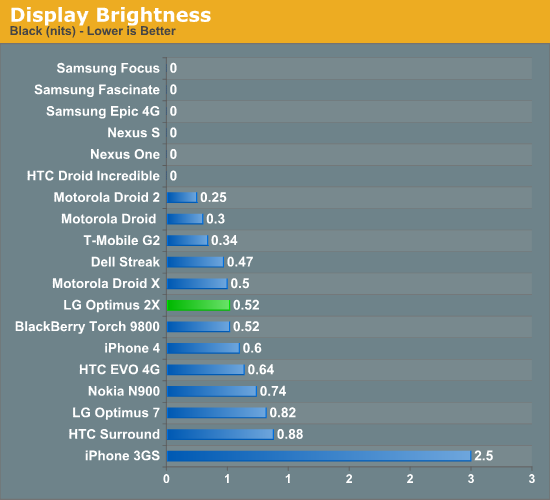

Though the 2X display is indeed IPS, it doesn’t score too highly in our display tests. I found contrast to be more than adequate, even if it isn’t AMOLED. At maximum brightness there’s just a bit too much brightness in the blacks which hurts that contrast score. I prefer LCD over AMOLED personally because of how grainy and off-white PenTile looks on most devices, so it’s nice to see an LCD. The automatic brightness dynamic range on the 2X could stand to be way bigger, it doesn’t go as dark as the darkest setting in pitch blackness, or as bright as maximum. That’s more of a complaint about how Android in general handles auto brightness by default than something LG is guilty of doing wrong. It's a shame we don't have the same kind of color calibration checks on smartphones as we do displays, because subjectively the display looked just about perfect. Auto brightness also sometimes seems to change brightness abruptly, without a gradual transition.
We talked in the physical impressions area about how the display surface is curved. It’s a gentle curve out at the edge which slopes down to meet flush the plastic lip running around the edge. If you put the phone face down, it seems that these areas are slightly raised, and thus the area that scratches is out at the start of that curve. What’s more interesting though is that several times I’ve noticed that with the sun or bright light at the side, light will enter through the raised curve and totally internally reflect all the way across the surface of the display. The result is that you see a ton of repeated vertical lines across the phone from light reflecting off the front and back surfaces of the glass. It’s a weird effect to describe, but I’ve seen it happen twice now during brief stints outside.
Viewing angles are decent, though there’s a bit more color distortion when viewed from extreme horizontal angles. The slight curve doesn’t really affect viewing angles in that direction—it’s nowhere as extreme as the Dell Venue Pro. Likewise, viewing angles in the vertical direction are great.
Outdoors there’s a bit of glare, including an odd secondary reflection from the second (back) surface of the glass. The result is that when you get glare outdoors, there are two images. One much more visible reflection from the first surface, another fainter image from the second surface. I haven’t really noticed it as much on any other device as I do with the 2X. It isn’t honestly a problem outdoors, just something worth noting. It’s too bad that LG couldn’t toss their super bright “Nova” display on the 2X, but as it stands right now LG has a pretty decent IPS on the phone.
The final interesting thing is an odd option under the display settings page. At the bottom is the option to change the Android display font. There are 7 fonts options, including the default Dorid Sans font, two other sans-serif fonts (one of which appears monospace), three nightmarish script fonts, and a serif font.
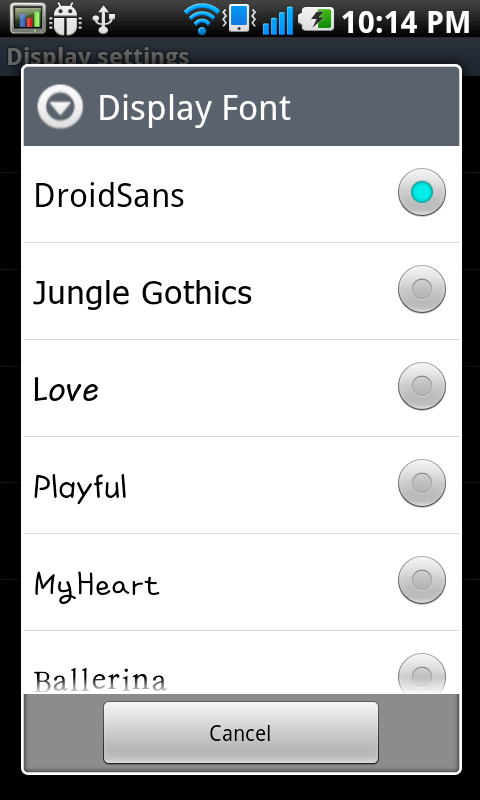

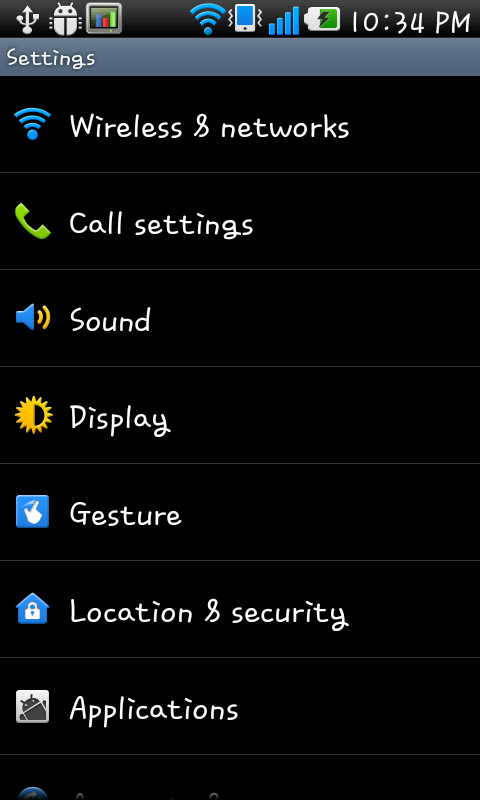
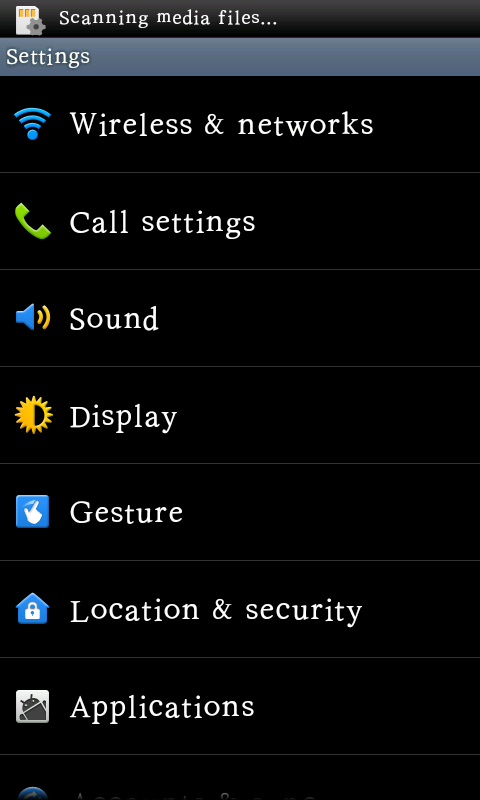
It's definitely not something I'd change yet (mostly because the alternatives to Droid Sans are visual atrocities), but this is the first time I've seen font changing on Android outside of the rooted/modding crowd.


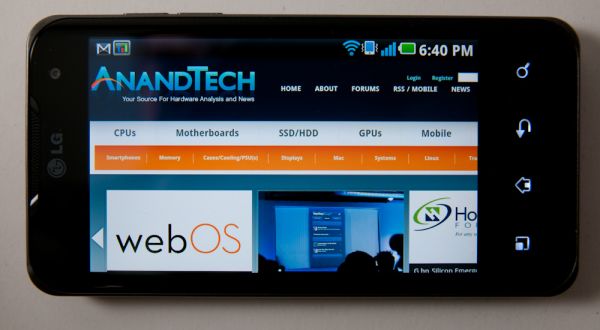














75 Comments
View All Comments
GoodRevrnd - Tuesday, February 8, 2011 - link
TV link would be awesome, but why would you need the phone to bridge the TV and network??aegisofrime - Monday, February 7, 2011 - link
May I suggest x264 encoding as a test of the CPU power? There's a version of x264 available for ARM chips, along with NEON optimizations. Should be interesting!Shadowmaster625 - Monday, February 7, 2011 - link
What is the point in having a high performance video processor when you cannot do the two things that actually make use of it? Those two things are: 1. Watch any movie in your collection without transcoding? (FAIL) 2. Play games. No actual buttons = FAIL. If you think otherwise then you dont actually play games. Just stick with facebook flash trash.TareX - Wednesday, February 9, 2011 - link
The only reason I'd pay for a dual core phone is smooth flash-enabled web browsing, not gaming.zorxd - Monday, February 7, 2011 - link
Stock Android has it too. There is also E for EDGE and G for GPRS.Exophase - Monday, February 7, 2011 - link
Hey Anand/Brian,There are some issues I've found with some information in this article:
1) You mention that Cortex-A8 is available in a multicore configuration. I'm pretty sure there's no such thing; you might be thinking of ARM11MPCore.
2) The floating point latencies table is just way off for NEON. You can find latencies here:
http://infocenter.arm.com/help/index.jsp?topic=/co...
It's the same in Cortex-A9. The table is a little hard to read; you have to look at the result and writeback stages to determine the latency (it's easier to read the A9 version). Here's the breakdown:
FADD/FSUB/FMUL: 5 cycles
FMAC: 9 cycles (note that this is because the result of the FMUL pipeline is then threaded through the FADD pipeline)
The table also implies Cortex-A9 adds divide and sqrt instructions to NEON. In actuality, both support reciprocal approximation instructions in SIMD and full versions in scalar. The approximation instructions have both initial approximation with ~9 bits of precision and Newton Rhapson step instructions. The step instructions function like FMACs and have similar latencies. This kind of begs the question of where the A9 NEON DIV and SQRT numbers came from.
The other issue I have with these numbers is that it only mentions latency and not throughput. The main issue is that the non-pipelined Cortex-A8 FPU has throughput almost as bad as its latency, while all of the other implementations have single cycle throughput for 2x 64-bit operations. Maybe throughput is what you mean by "minimum latency", however this would imply that Cortex-A9 VFP can't issue every cycle, which isn't the case.
3) It's obvious from the GLBenchmark 2.0 Pro screenshot that there are some serious color limitations from Tegra 2 (look at the woman's face). This is probably due to using 16-bit. IMG has a major advantage in this area since it renders at full 32-bit (or better) precision internally and can dither the result to 16-bit to the framebuffer, which looks surprisingly similar in quality to non-dithered 32-bit. This makes a 16-bit vs 16-bit framebuffer comparison between the two very unbalanced - it's far more fair to just do both at 32-bit, but it doesn't look like the benchmark has any option for it. Furthermore, Tegra 2 is limited to 16-bit (optionally non-linear) depth buffers, while IMG utilizes 32-bit floating point depth internally. This is always going to be a disadvantage for Tegra 2 and is definitely worth mentioning in any comparison.
Finally I feel like ranting a little bit about your use of the Android Linpack test. Anyone with a little common sense can tell that a native implementation of Linpack on these devices will yield several dozen times more than 40MFLOPS (should be closer to 1-4 FLOP/CPU cycle). What you see here is a blatant example of Dalvik's extreme inability to perform with floating point code that extends well beyond an inability to perform SIMD vectorization.
metafor - Monday, February 7, 2011 - link
According to the developer of Linpack on Android:http://www.greenecomputing.com/category/android/
It is mostly FP64 calculations done on Dalvik. While this may not be the fastest way to go about doing linear algebra, it is a fairly good representation of relative FP64 performance (which only exist in VFP).
And let's face it, few app developers are going to dig into Android's NDK and write NEON optimized code.
Exophase - Monday, February 7, 2011 - link
Then let's ask this instead: who really cares about FP64 performance on a smartphone? I'd also argue that it is not even a good representation of relative FP64 performance since that's being obscured so much by the quality of the JITed code. Hence why you see Scorpion and A9 perform a little over twice as fast as A8 (per-clock) instead of several times faster. VFP is still in-order on Cortex-A9, competent scheduling matters.Maybe a lot of developers won't write NEON code on Android, but where it's written it could very well matter. For one thing, in Android itself. And theoretically one day Dalvik could actually be generating NEON competently.. so some synthetic tests of NEON could be a good look at what could be.
metafor - Monday, February 7, 2011 - link
Well, few people really :)Linpack as it currently exists on Android probably doesn't tell very much at all. But if you're just going to slap together an FP heavy app (pocket scientific computing anyone?) and aren't a professional programmer, this likely represents the result you see.
I wouldn't mind seeing SpecFP ported natively to Android and running NEON. But alas, we'd need someone to roll up their sleeves and do that.
I did do a native compile of Linpack using gcc to test on my Evo, though. It's still not SIMD code, of course, but native results using VFP were around the 70-80MFLOPS mark. Of course, it's scheduling for the A8's FPU and not Scorpion's.
Anand Lal Shimpi - Monday, February 7, 2011 - link
Thanks for your comment :)1) You're very right, I was thinking about the ARM11 - fixed :)
2) Make that 2 for 2. You're right on the NEON values, I mistakenly grabbed the values from the cycles column and not the result column. The DIV/SQRT columns were also incorrect, I removed them from the article.
I mentioned the lack of pipelining in the A8 FPU earlier in the article but I reiterated it underneath the table to hammer the point home. I agree that the lack of pipelining is the major reason for the A8's poor FP performance.
3) Those screenshots were actually taken on IMG hardware. IMG has some pretty serious rendering issues running GLBenchmark 2.0.
4) I'm not happy with the current state of Android benchmarks - Linpack included. Right now we're simply including everything we can get our hands on, but over the next 24 months I think you'll see us narrow the list and introduce more benchmarks that are representative of real world performance as well as contribute to meaningful architecture analysis.
Take care,
Anand